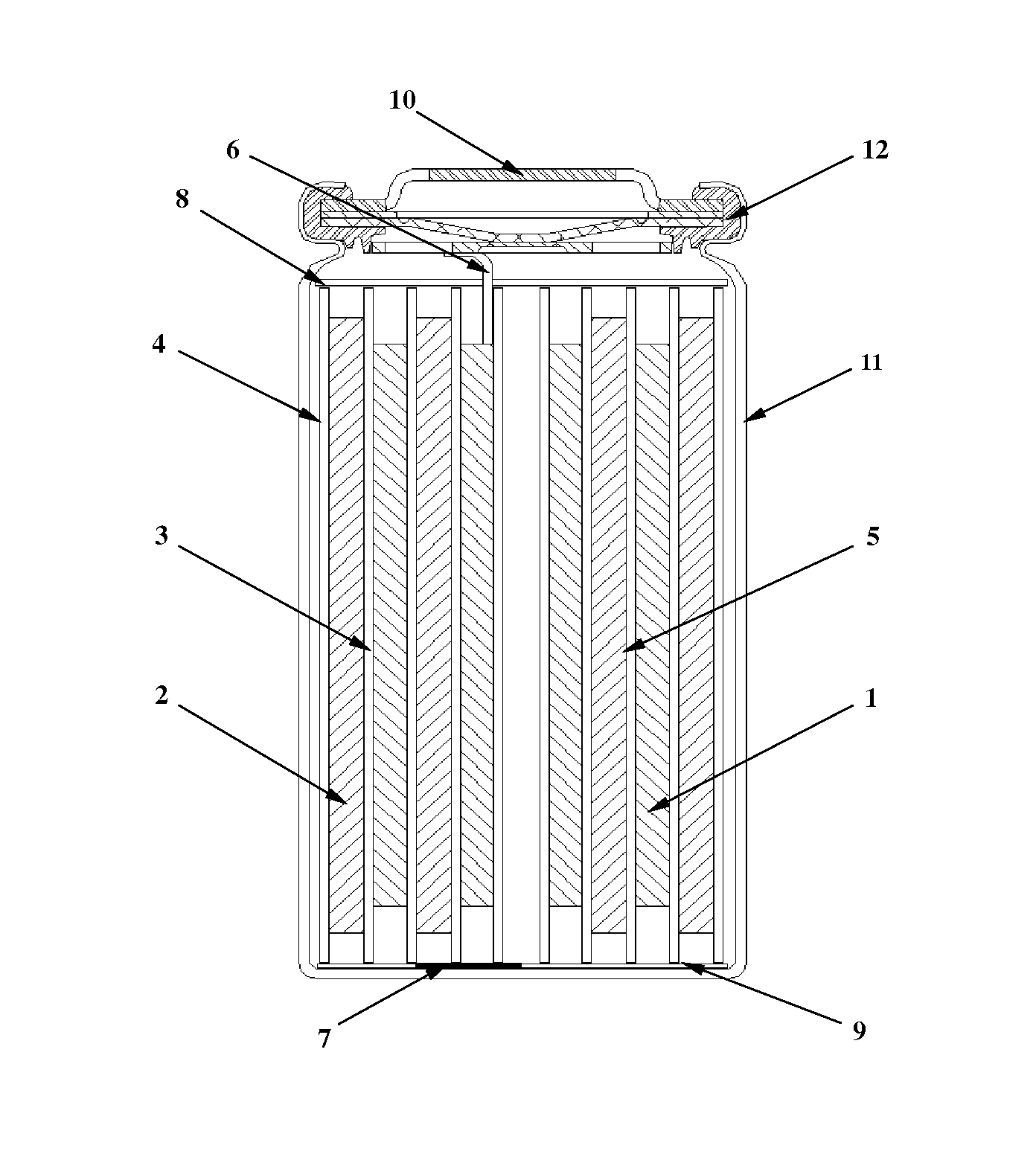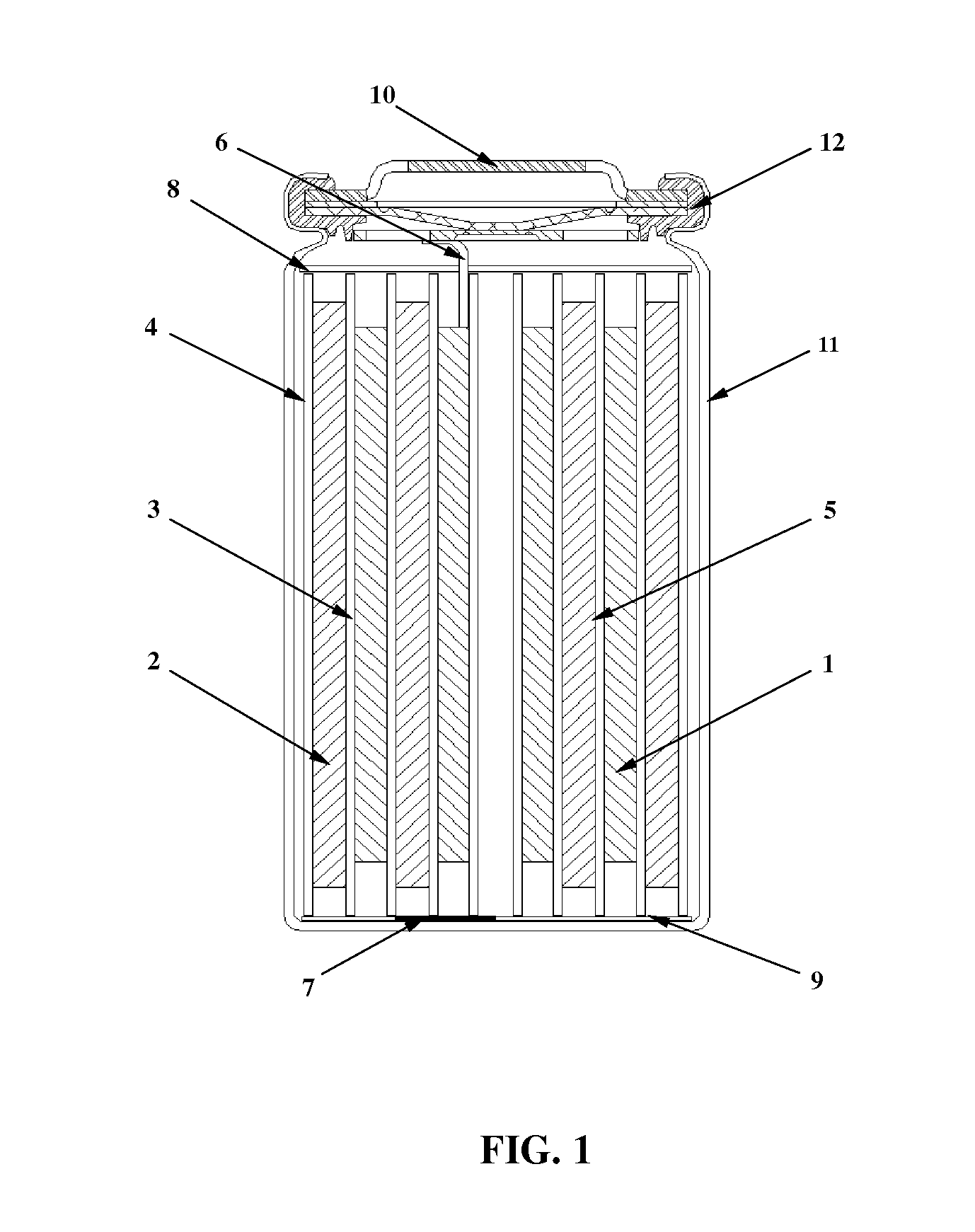Additives for improving the high temperature performance in non-aqueous rechargeable lithium-ion batteries
a rechargeable lithium-ion battery, high temperature performance technology, applied in the field of lithium-ion batteries, can solve the problems of battery performance deterioration, electrode impedance increase, film is usually not thermally stable, etc., to improve the thermal stability of electrodes within the battery, improve the storage and cycle life characteristics, and reduce resistance growth
- Summary
- Abstract
- Description
- Claims
- Application Information
AI Technical Summary
Benefits of technology
Problems solved by technology
Method used
Image
Examples
battery examples
[0024]A series of 18650 batteries was assembled as described above wherein different amounts of additives were incorporated into the electrolyte systems. Tables 1 and 3 give the experimental examples of the invention in regards to capacity recovery and AC impedance growth of the batteries after 28 days storage at 60° C. of two kinds of batteries fabricated using pure spinel cathode and a blend of spinel and Li(Ni1 / 3Mn1 / 3Co1 / 3)O2 cathode, respectively. Tables 2 and 4 present the discharge capacity retention after 500 cycles at 45° C. of two kinds of batteries fabricated using pure spinel cathode and a blend of spinel and Li(Ni1 / 3Mn1 / 3Co1 / 3)O2 cathode, respectively. The batteries with electrolyte containing the combination of the additives of 1,8-bis(dimethylamino)naphthalene and vinylene carbonate were used as examples. For purposes of comparison, batteries were also made without any additive and with one additive vinylene carbonate or 1,8-bis(dimethylamino)naphthalene only, respecti...
example 1
[0025]Combined additives of 0.5 wt % of 1,8-bis(dimethylamino)naphthalene and 2.0% of vinylene carbonate were added into the mixed solvents of EC, PC and DMC (2 / 1 / 3 in a volume ratio) with dissolved 1.0M LiPF6 salt in the spinel cathode batteries. The capacity recovery and impedance growth are listed in Table 1 for the fully charged batteries containing the electrolyte solution after storing at 60° C. for 28 days. Table 2 shows the discharge capacity retention of the batteries after cycling at C-rate for 500 cycles at 45° C.
TABLE 1ExampleAdditiveCapacityACZ (mohm)ACZ (mohm)numberAdditiveAmount (wt %)Recovery (%)Before storageAfter storageExample 1Proton-sponge + VC0.5 + 2.080.514.026.0Example 2Proton-sponge + VC1.0 + 2.079.214.028.0ComparativeNoneNone70.214.043.5Example 1ComparativeProton-sponge1.075.714.038.0Example 2ComparativeVC2.075.114.029.5Example 3
TABLE 2ExampleAdditiveCapacity retentionnumberAdditiveAmount (wt %)after 500 cycles (%)Example 1Proton-sponge + VC0.5 + 2.080.4Exa...
example 2
[0026]1.0 wt % of 1,8-bis(dimethylamino)naphthalene together with 2.0% of vinylene carbonate were added into mixed solvents of EC, PC and DMC (2 / 1 / 3 in a volume ratio) with dissolved 1.0M LiPF6 salt in the spinel cathode batteries. Table 1 presents the capacity recovery and impedance growth for the fully charged batteries containing the electrolyte solution after storing at 60° C. for 28 days. The discharge capacity retention of the batteries after cycling at C-rate for 500 cycles at 45° C. is shown in Table 2.
PUM
| Property | Measurement | Unit |
|---|---|---|
| height | aaaaa | aaaaa |
| diameter | aaaaa | aaaaa |
| temperature | aaaaa | aaaaa |
Abstract
Description
Claims
Application Information
 Login to View More
Login to View More - R&D
- Intellectual Property
- Life Sciences
- Materials
- Tech Scout
- Unparalleled Data Quality
- Higher Quality Content
- 60% Fewer Hallucinations
Browse by: Latest US Patents, China's latest patents, Technical Efficacy Thesaurus, Application Domain, Technology Topic, Popular Technical Reports.
© 2025 PatSnap. All rights reserved.Legal|Privacy policy|Modern Slavery Act Transparency Statement|Sitemap|About US| Contact US: help@patsnap.com



